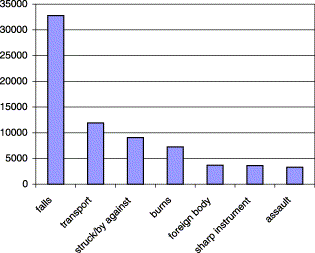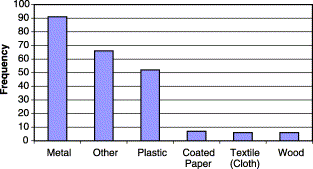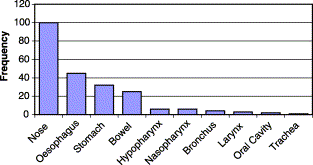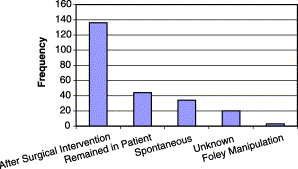Abstract
Introduction: The Red Cross Children's Hospital is the only children's hospital in South Africa. It has a dedicated trauma unit for all children under the age of 13 and serves a population of approximately 2 million inhabitants. As part of the Child Accident Prevention Foundation program we have kept a database of all children treated for trauma in our hospital since 1991. Presently, we have over 88,000 entries in our database. Aim: To study our experience with ingested foreign bodies in children. Materials and methods: A retrospective study was performed using the Child Accident Prevention Foundation of Southern Africa (CAPFSA) database of a total of 3677 patients presenting with foreign bodies. The hospital folders were searched using a standardised data extraction form. Only foreign bodies aspirated or ingested were included. Results: To date, 241 folders have been analysed. Demographics: Both sexes were equally affected (boys, 49%). Age ranged between 0 and 12 years, although there was only one child under the age of 1. At the age of 3 years, there was a peak in incidence (24% of all cases). Nature of ingested object: Although the objects were from a range of materials, most were metal (40%) or plastic (23%). The most commonly ingested object was a coin (28%), a ball (20%) or bone (8%). The size ranged from 0.1 to 3 cm (as measured by virtual ring), the most common size of an ingested foreign body was 0.5 cm. Anatomical site: The most common anatomical site of impaction was the nose (41%), followed by the esophagus (20%), the stomach (14%) and bowel (11%). Other anatomical sites included hypopharynx, nasopharynx, bronchus, larynx and oral cavity. Severity of symptoms: Only 0.4% of our cases were assessed as being severe, 14% as moderate, and 44% as mild. Forty-two percent had no symptoms. Removal: Fifty-seven percent of ingested foreign bodies were removed surgically, 19% were left in situ, 14% spontaneously dislodged and only 1% was removed by Foley catheter manipulation. Conclusion: A presentation with a foreign body is quite common in our patient population, representing approximately 4.2% of all our cases. The majority of ingested foreign bodies produced mild or no symptoms, needed surgical removal and had no complications.
E-mail address: [email protected]
Popular choices
- Casinos Not On Gamstop
- Casinos Not On Gamstop
- UK Betting Sites
- UK Online Casinos Not On Gamstop
- UK Online Casinos Not On Gamstop
- Non Gamstop Casinos UK
- Slots Not On Gamstop
- Sites Not On Gamstop
- UK Casino Not On Gamstop
- Non Gamstop Casinos
- UK Online Casinos Not On Gamstop
- UK Online Casinos Not On Gamstop
- UK Online Casinos Not On Gamstop
- Casinos Not On Gamstop
- Top UK Slot Sites
- Casinos Not On Gamstop
- Non Gamstop Casino Sites UK
- Sites Not On Gamstop
- Casino Sites UK Not On Gamstop
- Casinos Not On Gamstop
doi:10.1016/S0531-5131(03)00979-8
Click here for the PDF version
Contents
1. Introduction
Injury continues to be the leading cause of childhood death; in fact, it still exceeds all other causes of death for children in the western world [1, 2]. The concept of "Trauma as a national disease" [3] is now generally accepted in South Africa. Although there has been a reduction in childhood morbidity and mortality due to prevention initiatives, trauma remains the leading health problem amongst children. Many studies have established that the survival rate of critically injured children can be improved by centralising care in tertiary paediatric trauma centres. Since the landmark conference on emergency medical services for children [4], there has been focus on the unique health needs for children. This strongly implies surgeons' responsibility for injury prevention and control [5].
During 1978, due to the growing concern about the number of child injuries in South Africa, the Child Safety Centre was established as part of the Department of Paediatric Surgery at Red Cross Children's Hospital. By 1987 it became apparent however, that the knowledge and skills acquired and used by the Child Safety Centre on a local level were also needed nationally. Therefore, in April 1987 the Child Accident Prevention Foundation of Southern Africa (CAPFSA) was founded. Its primary goal is the prevention of accidental deaths, injuries, disability and suffering amongst children in South Africa through research, education, environmental change and recommendations for legislation. CAPFSA joined other countries that regard preventative education as the way to combat childhood injuries, rather than spending money solely on the establishment of expensive trauma facilities at hospitals and clinics.
To achieve this, we work in close cooperation with government, industry, nongovernmental and community-based organisations, community groups and individuals. Core activities of CAPFSA are data collection and interpretation, development of educational programs, health education and advising in legislation involving child health.
Children, and in particular children under the age of 3 are the most vulnerable for aspiration and ingestion of foreign bodies [6]. Since foreign bodies were identified as the fifth most common cause of patients presenting to our trauma unit, we embarked on this review to analyse our data regarding ingestion of foreign bodies to establish a South African perspective.
2. Materials and methods
Since 1991, a trauma record form has been completed for every patient visiting the Trauma Unit at the Red Cross Children's Hospital. These forms were captured in a Microsoft Access database. The database was explored for all children presenting with foreign bodies. Following this process a standardised datasheet (developed by RAM-Consulting®) was used to analyse these data further. Data were processed with another Microsoft Access database, specifically designed by RAM-Consulting® for in-depth analysis of ingested foreign bodies in children. Results were represented in graphic format with a short description.
3. Results
A total of 88,822 patients were treated at the trauma unit from 1991 to 2000. The most common injuries were falls (n=32,766) 21%, transport injuries (n=11,915) 13%, burns (n=7241) 8%, struck by/against objects (9064) 10%, foreign bodies (n=3677) 4%, sharp instruments (n=3601) 4% and assault (n=3302) 4% (Fig. 1). The most recent 241 patients (from 2001 and 2002) who presented with an ingested foreign body were analysed.
3.1. Demographics
Both sexes were equally affected (Boys, 49%). Age ranged between 0 and 12 years, although there was only one child under the age of 1. At the age of 3 years incidence peaked, with 24% of all cases (Fig. 2).
3.2. Nature of ingested objects
Although the objects were from a range of materials, most were metal (40%) or plastic (23%) (Fig. 3).
The most commonly ingested object was a coin (28%), a ball (20%) or bone (8%) (Fig. 4). The size ranged from 0.1 to 3 cm (as measured by virtual ring), the most common size of an ingested foreign body was 0.5 cm.
3.3. Anatomical site
The most common anatomical site of impaction was the nose (41%), followed by the esophagus (20%), the stomach (14%) and bowel (11%). Other anatomical sites included hypopharynx, nasopharynx, bronchus, larynx and oral cavity (Fig. 5).
3.4. Severity of symptoms
Only 0.4% of our cases were assessed as being severe, 14% as moderate, and 44% as mild. Forty-two percent had no symptoms.
3.5. Removal
Fifty-seven percent of ingested foreign bodies were removed surgically, 19% were left in situ, 14% spontaneously dislodged and only 1% was removed by Foley catheter manipulation (Fig. 6).
4. Discussion
Injury constitutes an important cause for morbidity and mortality in the world regardless of age and gender. Road traffic injuries, falls and interpersonal violence are amongst the main causes of injury-related disability and death [7]. Traditionally, injuries have been regarded as unavoidable accidents and only during the last decades they have been recognised as preventable [8].
The public health approach to injury prevention involves, as a first step, the determination of the magnitude, scope and characteristics of the problem [9]. We used the CAPFSA database as the main source for analysis of the ingestion injuries encountered in Cape Town. Following the detection of patients with a history of an ingested foreign body, the folders were further analysed using the special method developed by RAM Consulting®.
Using a uniform datasheet is of great benefit to compare studies from different continents and countries. It also had additional time saving effect, since most of our doctors are overworked as a result of the massive amount of trauma in our country. Only very few doctors find the energy and time to create a database for studies they want to perform.
That foreign body ingestion is common is reflected in the fact that it is the fifth most common cause of presentation to our trauma unit. However, it may look strange that only one patient (0.4%) presented with severe clinical distress. This may be due to transport related problems. Patients often do not have the financial resources to get to this hospital fast and therefore have emergency treatment at provisional centres. This is likely to create selection of our patient population. Severely distressed patients might have succumbed during the long wait for transport and mortuary data is being assessed to determine the effect of this problem.
The most commonly ingested foreign bodies were coins. This may result from a lack of children's toys in our communities. After the nose, the esophagus was the most commonly place of lodging. The vast majority of foreign bodies were removed surgically in theatre under general anaesthesia, by means of esophagoscopy. Foreign bodies in the stomach and bowel were left in situ, to be passed spontaneously. We had no patients return with complications from this policy.
Foley catheter manipulation was only performed in a minority of cases. Reasons for this are that we strongly discourage this procedure if the doctor is not very familiar with the procedure and if the child is younger than 3 years of age or uncooperative. There is always a possibility of aspiration during this manoeuvre, and an inflated Foley's balloon may obstruct the trachea and cause hypoxia.
5. Conclusion
Ingestion of foreign bodies occurs frequently in our patient population. By far the most common aspirated foreign body was a metal coin. On the basis of this study, we recommend strongly to keep coins away from children, especially from children under the age of 6 years. We will integrate findings of this study in our child accident preventative programs. Further analysis of data from 1991 to 1999 is underway.






